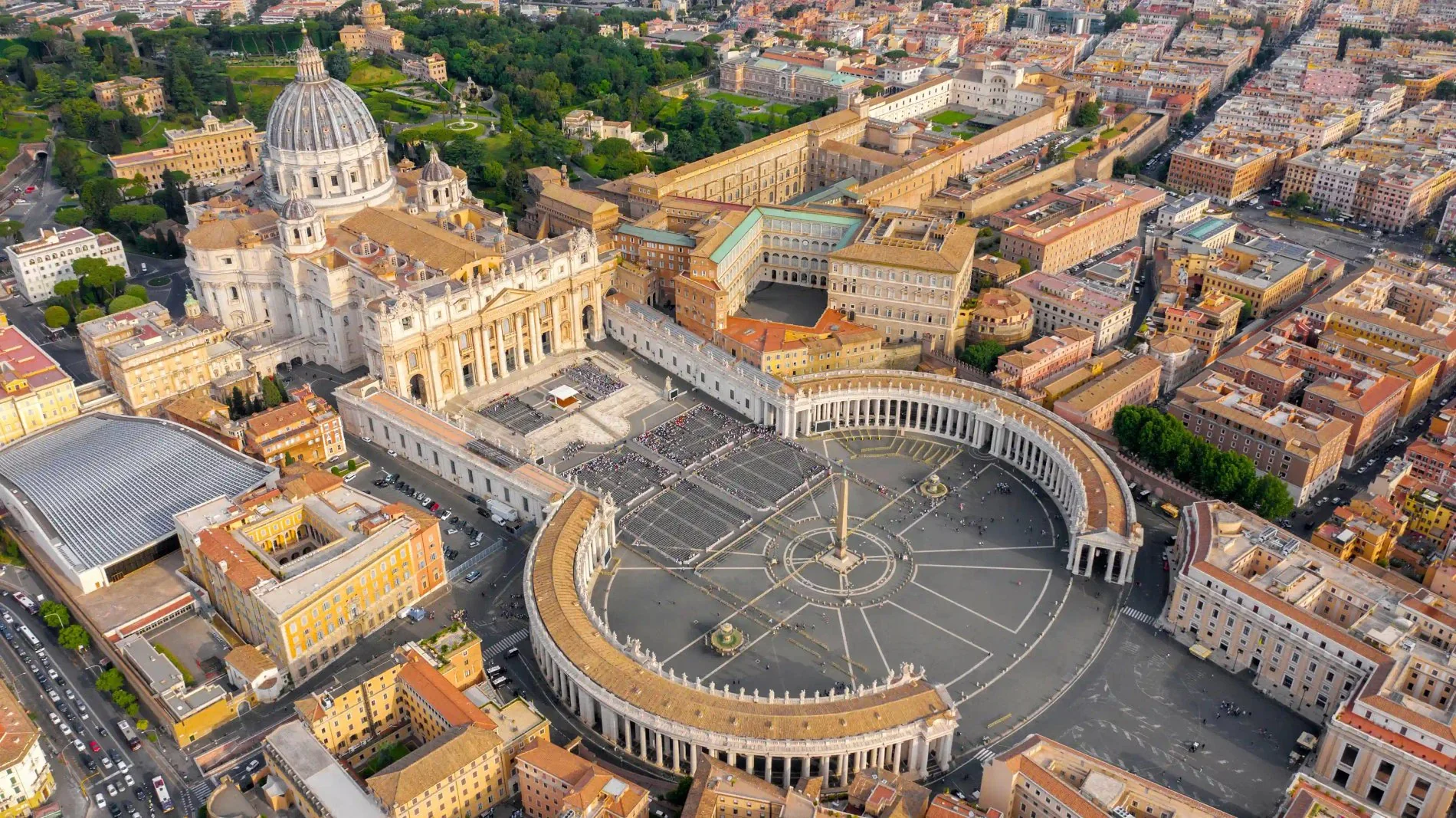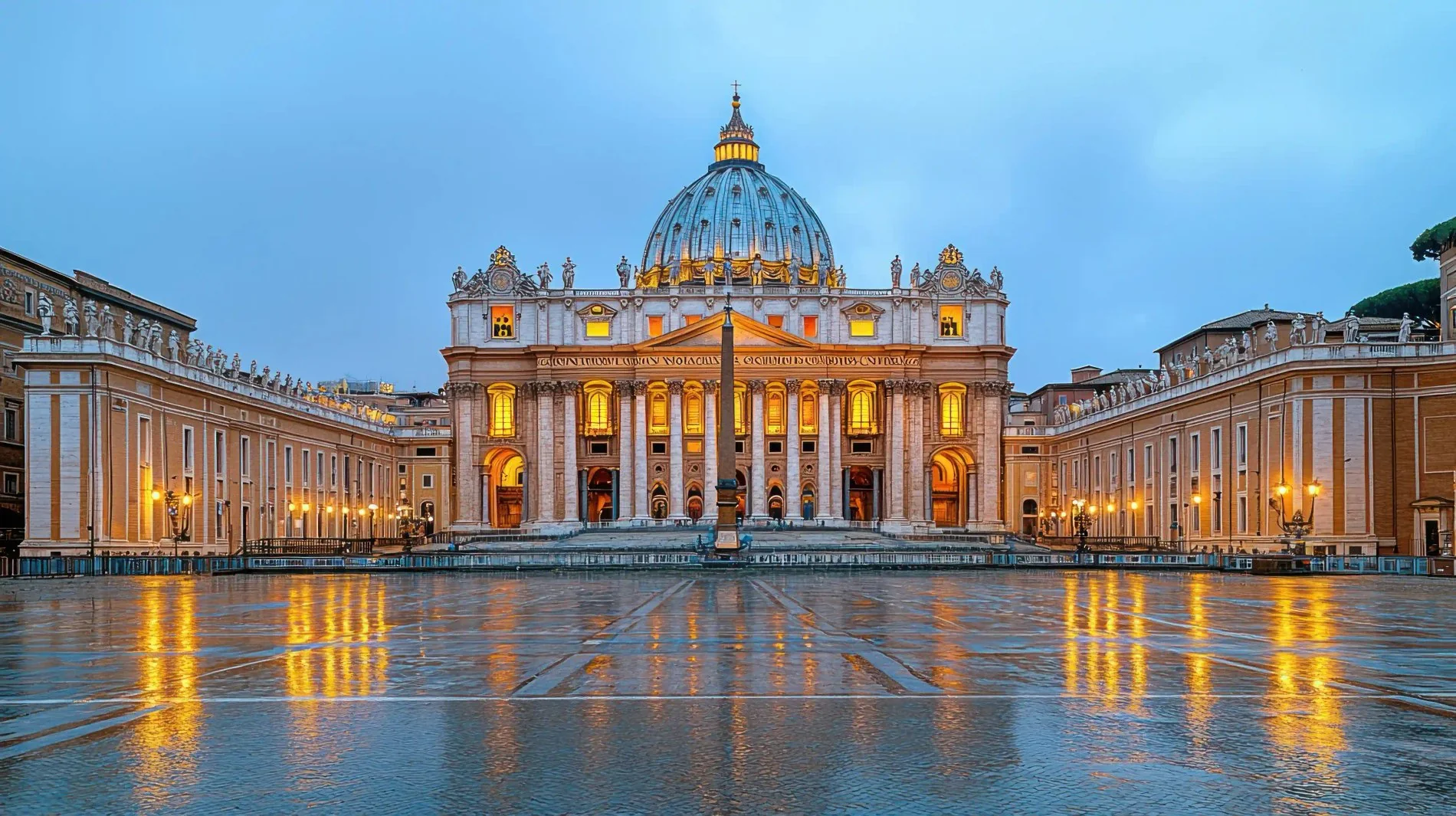Saint Peter's Square
St. Peter's Square is one of the most famous esplanades in the world and is the monumental entrance to the Vatican. With its spectacular dimensions (320 meters deep and 240 meters wide), it is designed to accommodate huge crowds of pilgrims. Every Sunday, more than 150,000 faithful gather here to attend Mass or the Angelus.
It is from this square that one enters St. Peter's Basilica, one of the great monuments of the Christian religion. With around 450 statues, 500 columns, and 50 altars, it is one of the most visited monuments in the world. The tomb of Saint Peter, one of the twelve apostles of Jesus, is located in the center of the building, in line with the square. He was the first pope in the history of Christianity. Many other popes also have their tombs in either the crypt or the nave, such as John Paul II.
The 9Hotel Cesàri is ideal for exploring St. Peter's Square.
Located in the heart of Rome, the 9Hotel Cesàri offers a strategic location for exploring Vatican City. When you stay with us, you can enjoy immediate proximity to the city's historical treasures while staying in a place steeped in history, open since 1787.
Before heading to St. Peter's Square, you can start your day with breakfast on our rooftop terrace, “La Terrazza del Cesàri.” This 400 m² terrace offers a panoramic view of the rooftops of Rome, from where you can see the majestic dome of St. Peter's in the distance, giving you a taste of what's to come on your visit.
In the evening, enjoy the tranquility of our rooms, which combine old-world charm with modern, refined décor. From Classic Rooms to Suites, our rooms offer all the comforts you need to rest after your long walks around Rome.
The Baroque Architecture of St. Peter's Square

The square's current appearance is the work of Baroque genius Gian Lorenzo Bernini (Le Bernin). Built between 1656 and 1667 under the commission of Pope Alexander VII, it is distinguished by its symbolic elliptical shape.
The most remarkable feature is the quadruple colonnade that surrounds the square. It consists of 284 Doric columns and 88 travertine pillars. Bernini designed this structure to represent the “maternal arms of the Church” opening to welcome Catholics, heretics, and non-believers. The top of this colonnade is crowned by 140 statues of saints, over 3 meters high, created by Bernini's students.
At the geometric center of the square stands the Vatican Obelisk, a 25-meter-high Egyptian monolith framed by two monumental fountains designed by Carlo Maderno and Carlo Fontana. Don't miss this interesting feature: look for the marble disc marked “Centro del Colonnato” on the ground. From this precise point, the four rows of columns align perfectly to form a single column.
The Obelisk and fountains in the center of the square
The geometric center of St. Peter's Square is marked by the Vatican Obelisk. It is a 25-meter-high monolith of red granite (over 40 meters including the base and cross), originally from Heliopolis in Egypt. Brought to Rome by Emperor Caligula in 37 AD, it originally adorned Nero's circus, the presumed site of Saint Peter's martyrdom. It is unique in that it does not feature any hieroglyphics. It was moved to its current location in 1586 by the architect Domenico Fontana.
To complete the symmetry of the square, two monumental fountains frame the obelisk. The fountain on the right (north) was sculpted by Carlo Maderno in 1613, while the one on the left (south) was created by Carlo Fontana in 1675 to replicate the first. The obelisk also serves as the gnomon for a huge sundial: the shadows cast on the pavement of the square mark noon and the solstices.
St. Peter's Basilica
It stands as one of the grand monuments of the Christian religion, boasting around 450 statues, 500 columns, and 50 altars, and ranking among the most visited landmarks in the world. Every Sunday, over 150,000 faithful gather for Mass in St. Peter's Square. The tomb of Saint Peter, one of Jesus' twelve apostles and the very first Pope in the history of Christianity, lies at the heart of the Basilica, as the renowned saying goes, "You are Peter, and on this rock I will build my Church." Several other Popes also have their final resting places in the Basilica's crypt or nave, including John Paul II. Over the years, various Popes have modified the Basilica's Renaissance style. From the 17th century onward, the Baroque style emerged in Italy, leading to more extravagant colors and decorations. The façade stands 45 meters tall and spans 115 meters in width, while the dome, the world's tallest, soars to 136 meters.
History of the world's largest Basilica

Roman Emperor Constantine was responsible for Rome's conversion to Christianity. Consequently, he commissioned the construction of the original St. Peter's Basilica in the 4th century, which was built over Saint Peter's tomb. This Basilica was emblematic of the strength of the Christian Roman Empire and the Christian faith at large.
Built in the traditional Roman architectural style—with columns, arches, and vaults—it was revered as one of the Empire's grandest and most beautiful churches. Consecrated in 324 AD, it became the religious epicenter of Rome and the Empire.
While the original Basilica underwent many modifications and restorations over the centuries, its significance as a symbolic and spiritual center of Christianity remained unshaken. Until the end of the 16th century, it was recognized as one of the world's most expansive churches and continued to be a pilgrimage site for believers globally.
A Shift in Scale
By the 16th century, as the first Basilica began deteriorating, the decision was made to raze it and build a new Basilica in its place. Pope Sixtus V initiated this endeavor in 1586.
Domenico Fontana, the lead architect, collaborated with other gifted architects and artists to design a Basilica that mirrored the contemporary architectural trends. The new Basilica embraced the Renaissance style but was later infused with Baroque elements.
Its construction was a colossal undertaking that spanned several decades, involving numerous artists, architects, and skilled laborers. Eventually, the new Basilica was consecrated in 1626 and gained renown as one of the world's largest and most exquisite churches. Sadly, the Colosseum's superior materials were sourced for its construction, explaining its current state.
The demolition of the original Basilica and the rise of the new one marked pivotal chapters in St. Peter's Basilica's history, resulting in an even grander and more majestic church, continuing to be a significant spiritual hub for Catholics worldwide.
The Crafting of the World's Tallest Dome
Michelangelo—famed Italian sculptor, painter, and architect, celebrated for masterpieces like the Sistine Chapel and David's statue—was the chief architect for the dome.
In 1547, Pope Julius III entrusted Michelangelo with the task of incorporating a dome into St. Peter's Basilica. He conceived this impressive dome with a central dome flanked by lanterns. Constructing it was technically challenging, given its massive size and weight.
Despite obstacles, Michelangelo persevered with the dome until his passing in 1564. Subsequent architects and engineers furthered his vision, making it one of the world's grandest domes. Completed in 1590, it became a defining symbol of St. Peter's Basilica.
Michelangelo's addition significantly elevated the Basilica's stature in Rome's skyline. His dome remains an exceptional example of Renaissance architecture in Italy and continues to be revered for its artistic brilliance and technical ingenuity.
Today, visitors can explore the dome up close, either by elevator or climbing 300 steps, revealing a breathtaking panorama of Rome and a unique perspective of the Basilica.
A New Façade's Introduction
In 1607, Pope Sixtus V initiated a project to add a façade to the existing Basilica to enhance its accessibility and appeal. Carlo Maderno was assigned this task, and he designed a grandiose façade infused with Baroque elements like columns, arches, statues, and decorative friezes.
The Baroque façade's construction was an ambitious project that spanned several years, culminating in its completion in 1614, becoming one of the most iconic features of St. Peter's Basilica.
Maderno's Baroque façade significantly enriched the Basilica's aesthetic, making it more welcoming for visitors. It seamlessly combined Renaissance and Baroque styles, rendering the church more harmonious. Maderno's Baroque façade remains a standout example of Italian Baroque architecture.
Necessary Restorations
By the 19th century, St. Peter's Basilica showed signs of wear due to its age and exposure to the elements. Pope Pius IX initiated a Basilica restoration project.
This endeavor was vast, spanning several years, and necessitated collaboration from numerous artists, architects, and skilled laborers. Restoration works included mosaics, murals, sculptures, and other decorative elements of the Basilica.
The 19th-century restoration ensured the Basilica's architectural and artistic integrity was preserved for future generations. It also enhanced the worship experience, offering a more comfortable and inviting environment for the faithful.
The restoration undertaken during Pope Pius IX's papacy underscores St. Peter's Basilica's significance to Christianity and the dedication to preserving its legacy. This effort also highlighted the Vatican's commitment to safeguarding Rome's historical sites and essential landmarks.
More recently, in the 20th century, Michelangelo's dome began displaying degradation signs. To address this, Pope John XXIII inaugurated a dome restoration project.
This restoration was another monumental undertaking that spanned several years and required the expertise of numerous architects, engineers, and skilled laborers. Restoration efforts included repairing cracks, restoring mosaics and murals, and updating interior lighting.
Lastly, it's noteworthy that many Popes are interred within the Basilica, including:
Benedict XVI (1922 - 2022)
John Paul II (1978-2005)
Paul VI (1963-1978)
John XXIII (1958-1963)
Pius XI (1922-1939)
Pius X (1903-1914)
Leo XIII (1878-1903)
Pius IX (1846-1878)


